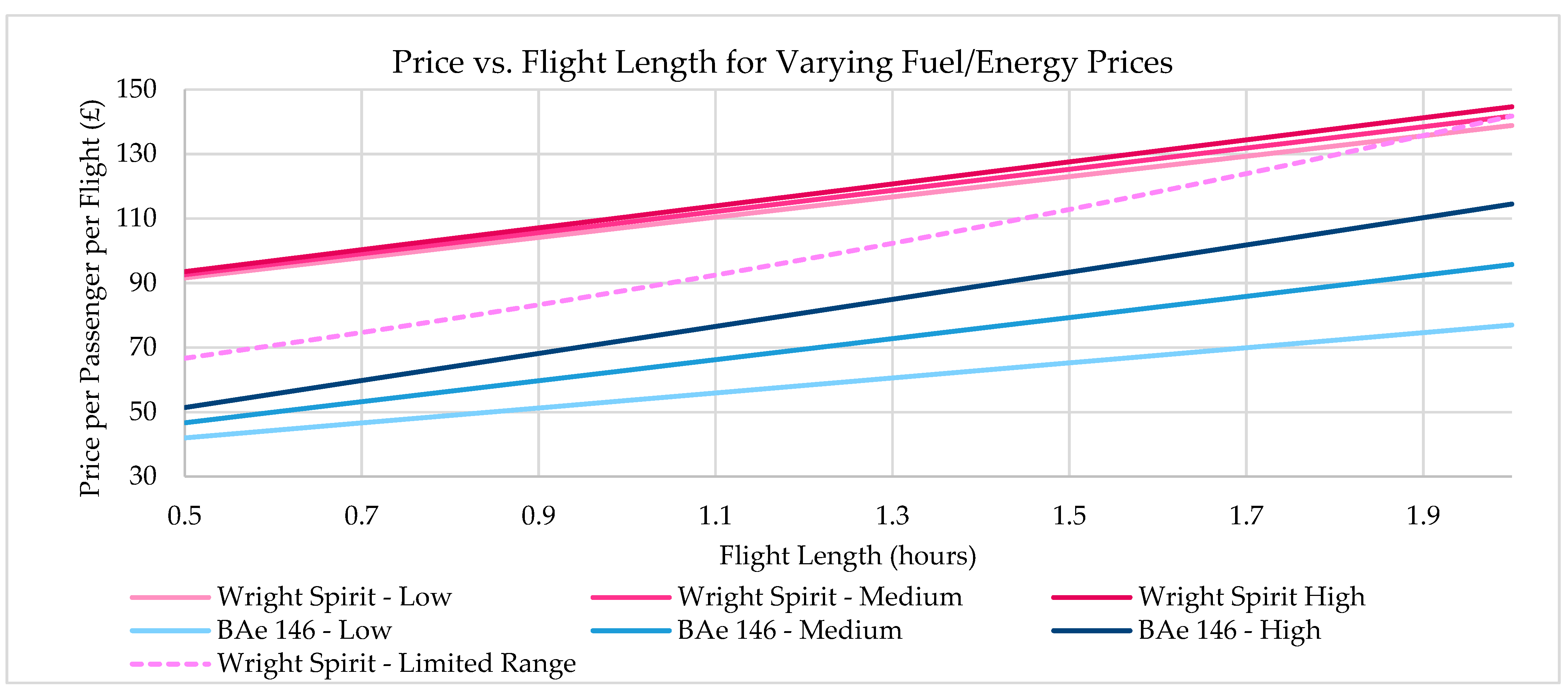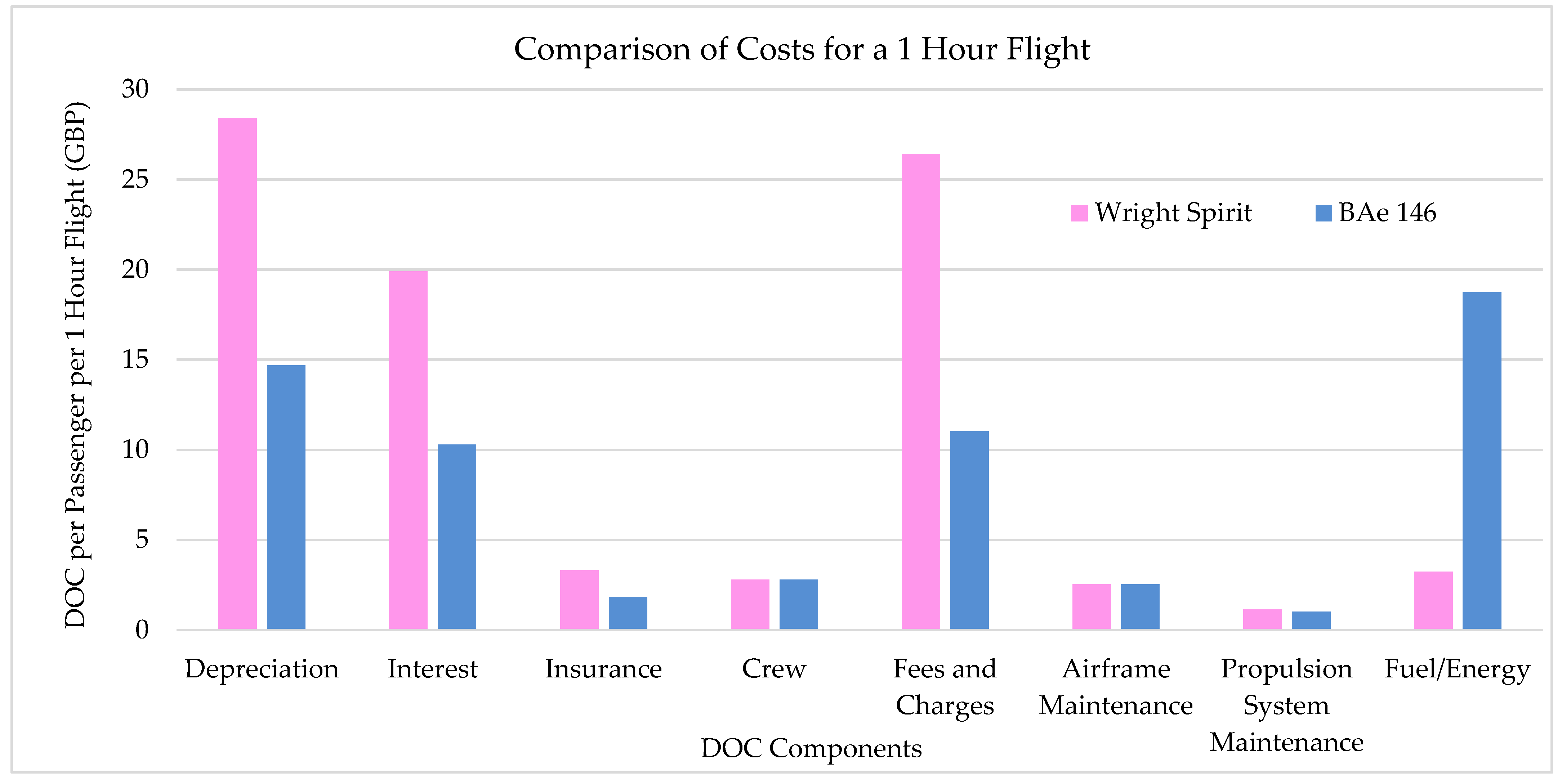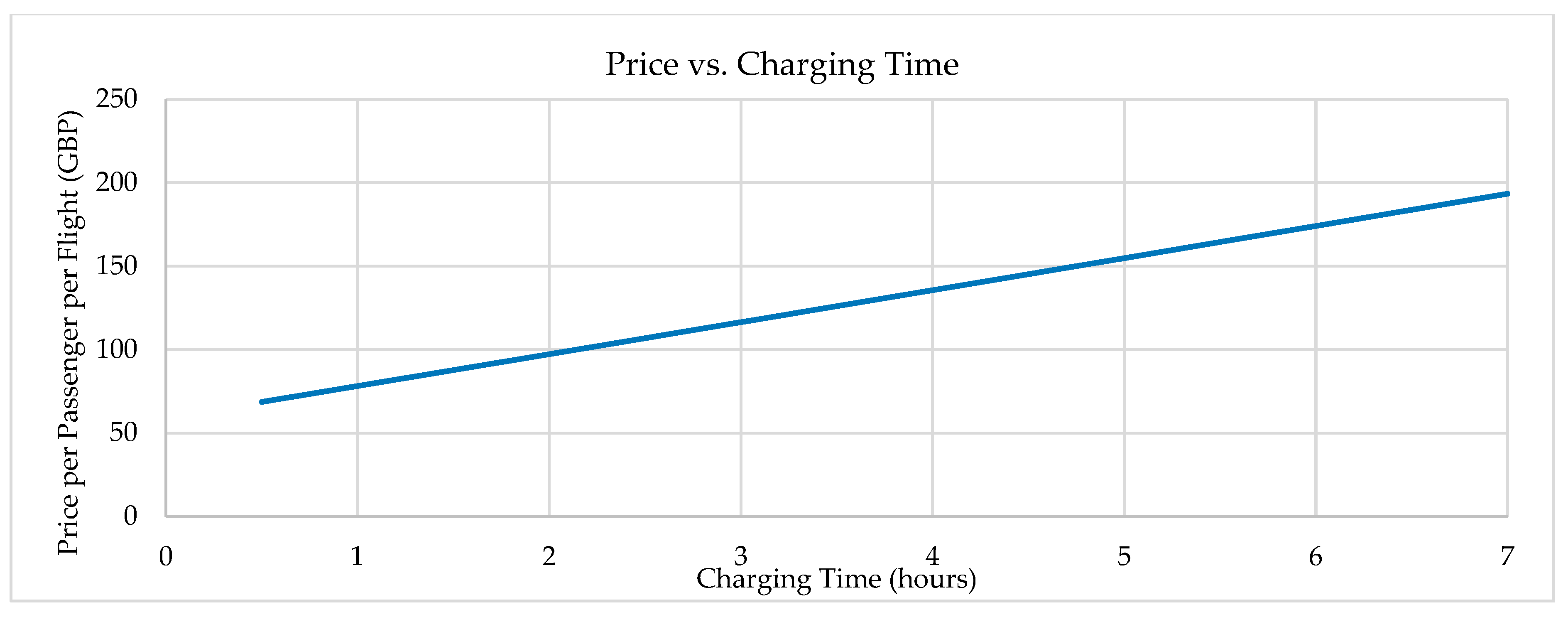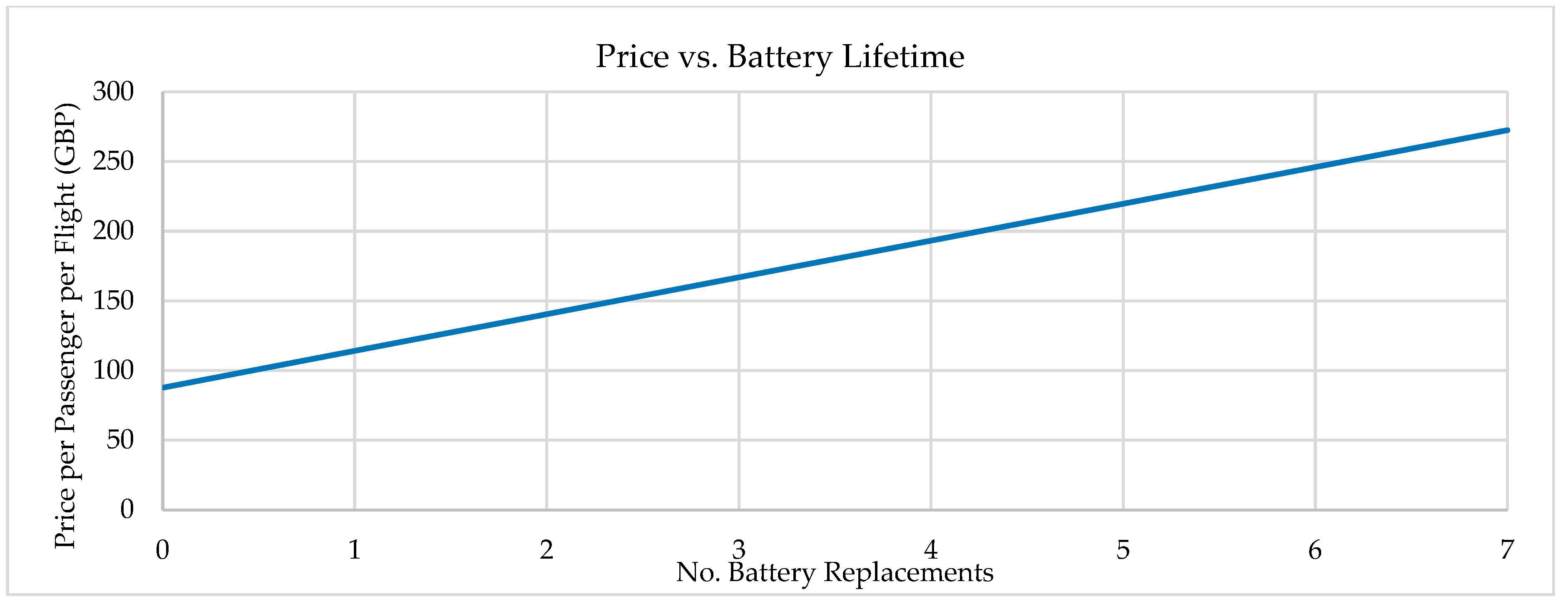An Analysis of Direct Operating Costs for the Wright Spirit Electric Aircraft
Abstract
:1. Introduction
- How will the DOC of the Wright Spirit compare to the BAe 146?
- How will a shift to electric aircraft within commercial flight affect ticket prices in today’s market?
- What are the governing factors when determining DOC?
2. Methods for DOC Calculation
2.1. Utilisation
2.2. Total Investment
2.3. Depreciation, Insurance and Interest
2.4. Crew
2.5. Fees and Charges
2.6. Airframe Maintenance
2.7. Propulsion System Maintenance
2.8. Fuel/Energy
2.9. Direct Operating Cost
3. Results
3.1. Price vs. Flight Time
3.2. Comparison of DOC Components in 1 Hour Flights
3.3. Effect of Charging Time and Battery Replacement
3.4. Comparison with Current Costs
4. Discussion
4.1. Comparison to the Previous Literature
4.2. Analysis of Assumptions
4.3. Driving Factors
4.4. Effect on Ticket Prices
5. Conclusions
Author Contributions
Funding
Data Availability Statement
Conflicts of Interest
References
- Directorate-General for Climate Action, Going Climateneutral by 2050. In A Strategic Long-Term Vision for a Prosperous, Modern, Competitive and Climate-Neutral EU Economy; European Commission: Brussels, Belgium, 2019. [CrossRef]
- Shahwan, K. Operating Cost Analysis of Electric Aircraft on Regional Routes. Bachelor’s Thesis, Department of Science and Technology, Linkoping University, Linköping, Sweden, 2021. [Google Scholar]
- International Air Transport Association. A Global Approach to Reducing Aviation Emissions. 2014. Available online: https://www.yumpu.com/en/document/view/318421/a-global-approach-to-reducing-aviation-emissions (accessed on 5 September 2024).
- Lee, M.; Li, L.K.B.; Song, W. Analysis of direct operating cost of wide-body passenger aircraft: A parametric study based on Hong Kong. Chin. J. Aeronaut. 2019, 32, 1222–1243. [Google Scholar] [CrossRef]
- Marksel, M.; Brdnik, A.P. Comparative Analysis of Direct Operating Cost: Conventional vs. Hydrogen Fuell Cell 19-Seat Aircraft. Sustain. Aviat. 2023, 15, 11271. [Google Scholar] [CrossRef]
- Medeiros, M.; Monjon, M.; Monzu Freire, C. Conceptual Design and Operating Costs Evaluation of All-Electric Aircraft for Regional Aviation. In Proceedings of the AIAA Propulsion Energy Forum 2020, Virtual, 24–26 August 2020. [Google Scholar] [CrossRef]
- Ploetner, K.O.; Schmidt, M.; Baranowski, D.; Isikveren, A.T.; Hornung, M. Operating Cost Estimation for Electric-Powered Transport Aircraft. In Proceedings of the 2013 Aviation Technology, Integration and Operations Conference, Los Angeles, CA, USA, 12–14 August 2013; American Institute of Aeronautics and Astronautics: Reston, VA, USA, 2013. [Google Scholar] [CrossRef]
- Kafui Ayetor, G.; Edem Dzebre, D.K.; Mensah, L.D.; Boahen, S.; Owura Amoabeng, K.; Kwaky Tay, G.F. Comparing the Cost per Mile of Electric Vehicles and Internal Combustion Engine Vehicles in Ghana. Transp. Res. Rec. J. Transp. Res. Board 2022, 2677, 682–693. [Google Scholar] [CrossRef]
- Adu-Gyamfi, B.A.; Good, C. Electric aviation: A review of concepts and enabling technologies. Transp. Eng. 2022, 9, 2666–2691. [Google Scholar] [CrossRef]
- Alrashed, M.; Nikolaidis, T.; Pilidis, P.; Jafari, S. Utilisation of turboelectric distribution propulson in commercial aviation: A review on NASA’s TeDP concept. Chin. J. Aeronaut. 2020, 34, 48–65. [Google Scholar] [CrossRef]
- Aerocorner. British Aero BAE 146—Price, Specs, Photo Gallery, History. Available online: https://aerocorner.com/aircraft/british-aero-bae-146/ (accessed on 11 March 2024).
- Hardiman, J. Quirky Quadjet: 40 Years of the British Aerospace 146. 2021. Available online: https://simpleflying.com/british-aerospace-146-40-years/ (accessed on 11 March 2024).
- Wright Electric. Available online: https://www.weflywright.com/motor (accessed on 11 March 2024).
- Battery Storage. 2024. Available online: https://www.theecoexperts.co.uk/solar-panels/storage-batteries-cost (accessed on 11 March 2024).
- Manager, S. 2023 Breakdown: Solar Panel Battery Costs in the UK. 2023. Available online: https://edanpower.co.uk/advice/solar-panel-battery-cost-uk/ (accessed on 11 March 2024).
- Alrashed, M.; Nikolaidis, T.; Pilidis, P.; Alrashed, W.; Jafari, S. Economic and environmental viability assessment of NASA’s turboelectric distribution propulsion. Energy Rep. 2020, 6, 1685–1695. [Google Scholar] [CrossRef]
- Felder, J.L. NASA N3-X with Turboelectric Distributed Propulsion. In Proceedings of the IMechE Disruptive Green Propulsion Technologies, London, UK, 16–17 November 2014; NASA Glenn Research Center: Cleveland, OH, USA, 2014. [Google Scholar]
- Ahlgren, L.; Simple Flying Staff. How Many Crew Are Required on an Aircraft? 2022. Available online: https://simpleflying.com/aircraft-flight-crew-requirements/ (accessed on 11 March 2024).
- British Airways. Cabin Crew. Available online: https://uk.indeed.com/cmp/British-Airways/salaries/Flight-Attendant (accessed on 11 March 2024).
- Academy A by LA. How Much Does a Pilot in the UK Earn? Available online: https://l3harrisairlineacademy.com/en-gb/about-us/blog/how-much-do-pilots-earn-in-the-uk/ (accessed on 11 March 2024).
- The Civil Aviation Authority. Transport Act 2000, Charges for Air Services, (Navigation Services Charges) Specification 2023; Civil Aviation Authority: London, UK, 2023. [Google Scholar]
- Ellichipuram, U. Heathrow Ordered to Lower Landing Charges Until 2026. Available online: https://www.airport-technology.com/news/heathrow-landing-charges/ (accessed on 11 March 2024).
- Licenced Aircraft Engineer Salary in United Kingdom—Average Salary. Available online: https://uk.talent.com/salary?job=licenced+aircraft+engineer#:~:text=How%20much%20does%20a%20Licenced%20aircraft%20engineer%20make%20in%20United%20Kingdom%3F&text=The%20average%20licenced%20aircraft%20engineer%20salary%20in%20the%20United%20Kingdom,to%20£74%2C280%20per%20year (accessed on 12 March 2024).
- British Aerospace BAE-146. Available online: https://en.wikipedia.org/wiki/British_Aerospace_146 (accessed on 12 March 2024).
- Rauch, D. Design Study of an Air Pump and Integral Lift Engine ALF-504 Using the Lycoming 502 Core; NASA Contractor Report NASA-CR-120992; NASA: Washington, DC, USA, 1972. [Google Scholar]
- Lycoming ALF-502. Available online: https://www.aarg.com.au/alf502.html (accessed on 17 March 2024).
- Lycoming T55—Wikimili, the Free Encyclopedia. Available online: https://wikimili.com/en/Lycoming_T55 (accessed on 17 March 2024).
- Fuel Consumption Table. 2017. Available online: https://natural-resources.canada.ca/sites/www.nrcan.gc.ca/files/oee/pdf/transportation/tools/fuelratings/2017%20Fuel%20Consumption%20Guide.pdf (accessed on 12 March 2024).
- The Definitive Guide to Wholesale Energy: How It Works, Prices & More, Love Energy Savings. Available online: https://www.loveenergysavings.com/business-energy/the-definitive-guide-to-wholesale-energy/#:~:text=According%20to%20the%20latest%20statistics,the%20cap%20in%20January%202024 (accessed on 5 September 2024).
- Book Cheap Flights and Holidays. Available online: https://www.easyjet.com/en/ (accessed on 5 September 2024).
- British Airways. Book Flights, Holidays, City Breaks & Check in Online. Available online: https://www.britishairways.com/travel/home/public/en_gb/ (accessed on 6 September 2024).
- Bradley, M.K.; Droney, C.K. Vol. 2, Subsonic Ultra Green Aircraft Research: Phase II—Volume II—Hybrid Electric Design Exploration; NASA: Washington, DC, USA, 2015; p. 72. [Google Scholar]
- Wright Battery Program. We Fly Wright. 2023. Available online: https://www.weflywright.com/battery-launch#:~:text=Wright's%20batteries%20aim%20to%20quadruple,milestone%20in%20sustainable%20aviation%20development (accessed on 5 September 2024).
- ‘Spirit of Innovation’ Stakes Claim to Be the World’s Fastest. 2021. Available online: https://www.rolls-royce.com/media/press-releases/2022/20-01-2022-the-spirit-of-innovation-officially-breaks-speed-record.aspx (accessed on 14 March 2024).
- Eurostar. Train Search. Available online: https://www.eurostar.com/uk-en (accessed on 17 March 2024).
- Trainline—Buy Train Tickets for Travel in the UK and Europe. Available online: https://www.thetrainline.com/ (accessed on 17 March 2024).
- Doganis, R. Flying Off Course: Airline Economics and Marketing; Routledge: London, UK, 2010. [Google Scholar]
- HM Revenue & Customs. Rates for Air Passenger Duty. 2023. Available online: https://www.gov.uk/guidance/rates-and-allowances-for-air-passenger-duty (accessed on 14 March 2024).
- Faelli, F. Consumers Say Their Environmental Concerns Are Increasing Due to Extreme Weather; Study Shows They’re Willing to Change Behavior, Pay 12% More for Sustainable Products. 2023. Available online: https://www.bain.com/about/media-center/press-releases/2023/consumers-say-their-environmental-concerns-are-increasing-due-to-extreme-weather-study-shows-theyre-willing-to-change-behavior-pay-12-more-for-sustainable-products/ (accessed on 14 March 2024).






| Departure City | Flight Time | EasyJet Ticket Price Range [30] (GBP) | British Airways Ticket Price Range [31] (GBP) | Wright Spirit DOC (GBP) per Passenger |
|---|---|---|---|---|
| Paris | 1:15 | 90.24–132.21 | 64.60–231.28 | 99.83 |
| Edinburgh | 1:30 | 106.47–126.47 | 69.42–340.42 | 110.56 |
| Geneva | 1:45 | 62.94–86.47 | 71.77–134.79 | 126.81 |
| Munich | 2:00 | 143.48–214.04 | 138.55–207.78 | 141.76 |
| Battery Cost per kWh (GBP) | Cost per Passenger per 1 h Flight (GBP) | % Change to 1 h Flight | Cost per Passenger per 2 h Flight (GBP) | % Change to 2 h Flights |
|---|---|---|---|---|
| 250 | 68.02 | −23 | 93.21 | −34 |
| 500 | 74.62 | −15 | 109.39 | −23 |
| 1000 | 87.81 | 0 | 141.76 | 0 |
| 1500 | 101.00 | 15 | 174.14 | 23 |
| 2000 | 114.19 | 30 | 206.51 | 46 |
| 5000 | 193.32 | 120 | 400.74 | 183 |
| Number of Cycles | Number of Battery Replacements | DOC (GBP) |
|---|---|---|
| 1000 | 17 | 536.23 |
| 2000 | 8 | 298.83 |
| 5000 | 3 | 166.94 |
| Departure City | DOC (GBP) | Administration, Marketing and Sales (GBP) | Air Passenger Duty (GBP) | Total (GBP) | British Airways Price Range (GBP) | Potential Profit (GBP) |
|---|---|---|---|---|---|---|
| Paris | 99.83 | 23.27 | 13 | 136.10 | 64.60–231.28 | 95.18 |
| Edinburgh | 110.56 | 26.29 | 7 | 146.13 | 69.42–340.42 | 194.29 |
| Geneva | 126.81 | 29.55 | 13 | 169.36 | 71.77–134.79 | −34.57 |
| Munich | 141.76 | 33.04 | 13 | 187.80 | 138.55–207.78 | 19.98 |
Disclaimer/Publisher’s Note: The statements, opinions and data contained in all publications are solely those of the individual author(s) and contributor(s) and not of MDPI and/or the editor(s). MDPI and/or the editor(s) disclaim responsibility for any injury to people or property resulting from any ideas, methods, instructions or products referred to in the content. |
© 2024 by the authors. Licensee MDPI, Basel, Switzerland. This article is an open access article distributed under the terms and conditions of the Creative Commons Attribution (CC BY) license (https://creativecommons.org/licenses/by/4.0/).
Share and Cite
Goodge, K.; Withey, P. An Analysis of Direct Operating Costs for the Wright Spirit Electric Aircraft. Aerospace 2024, 11, 1007. https://doi.org/10.3390/aerospace11121007
Goodge K, Withey P. An Analysis of Direct Operating Costs for the Wright Spirit Electric Aircraft. Aerospace. 2024; 11(12):1007. https://doi.org/10.3390/aerospace11121007
Chicago/Turabian StyleGoodge, Katie, and Paul Withey. 2024. "An Analysis of Direct Operating Costs for the Wright Spirit Electric Aircraft" Aerospace 11, no. 12: 1007. https://doi.org/10.3390/aerospace11121007
APA StyleGoodge, K., & Withey, P. (2024). An Analysis of Direct Operating Costs for the Wright Spirit Electric Aircraft. Aerospace, 11(12), 1007. https://doi.org/10.3390/aerospace11121007







